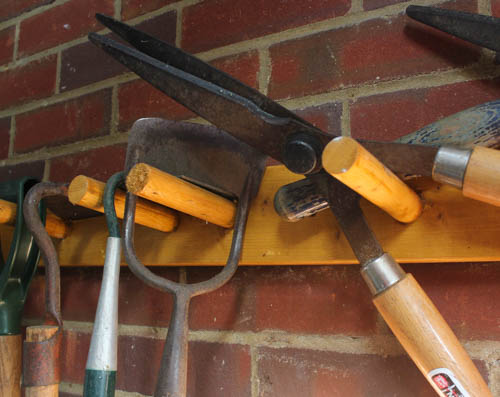
Winter is a great opportunity to check over hand tools, replacing broken handles and sharpening blades of hoes, shears, loppers and spades. Brush off any soil, clean off rust with wire wool, then use a fine file to flatten notches on the cutting edge. Years ago when I worked on the local Parks’ department, Fred, the play equipment maintenance man sharpened our hoes each day with an angle grinder – they cut the weeds like a knife. Don’t cutting check the edge with your finger; try cutting a branch or twig instead, for obvious reasons. spray the surface with water repellent and treat wooden handles with linseed oil before hanging them in the shed.
The time of year when Amaryllis, or Hippeastrum bulbs are for sale ready for flowering at Christmas or the New Year. Start them into growth by watering sparingly at first; just a trickle of tepid water around the bulb, increasing the amount as growth appears. Once they are actively growing, keep the compost moist but not waterlogged and take care not to get the growth tip wet. They like temperatures between around 20 C so a warm sunny window is ideal but don’t let room temperatures get too hot, to prolong the flowering period. (This applies to ‘Indian Azalea’s’, ‘Poinsettia’ and ‘Christmas cactus’ too). Stake the flower stems carefully to prevent them from falling over and rotate the pot a quarter of a turn each day, for balanced growth then sit back and enjoy the display.
Don’t forget to remove any of your houseplants from the windowsill during the night, as they are easily damaged by low temperatures.
Cover your root crops like parsnips, maincrop carrots, swedes with straw, bracken, or layers of cardboard to stop the ground from freezing then you can lift them easily when needed. In colder areas, they can be lifted, brushed clean of soil and stored in damp sand in the shed or garage.
Winter, usually recognised as the time from leaf fall to the beginning or March at bud burst is the traditional time for planting bare-root trees, shrubs and roses. They tend to be cheaper than containerised plants and are certainly a bargain. Don’t plant when the ground it waterlogged or frozen. Plant in a square hole, slightly larger than the size of the root ball, break up the sides and base of the hole with a garden fork, insert a stake on the windward size of the tree if needed. Plant at the same level that the plant was in the nursery, sprinkle mycorrhizal fungi around the roots then backfill, firming the soil in layers so there are no air gaps around the roots.
Don’t forget to cover ‘Holly’ berries with horticultural fleece to protect them from the birds, then you’ll have some for your festive display. When storing wood for open fires remember that dry wood ignites easily but burns faster while wet wood is better for a slow burn. Ideally you should have a mixture of both, then all you need are the chestnuts!
Happy Christmas!


